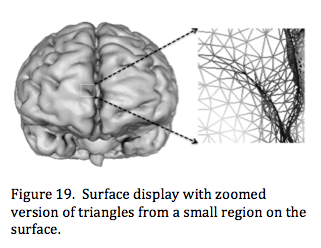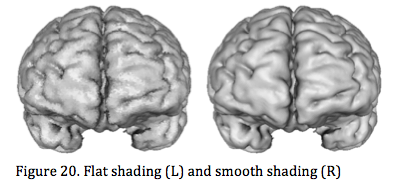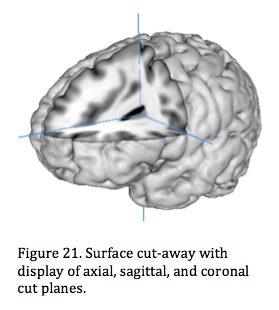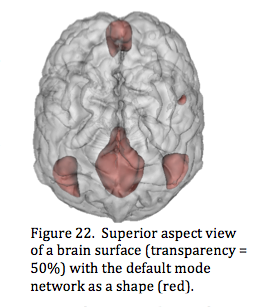Download Using_Mango.pdf
Surface Rendered Images
Mango provides viewing and analysis capabilities for surface images synthesized from objects in linked voxel-based images. These 3-D images can be dynamically moved and rotated to aid in viewing an object's surface from any direction. Surface-based analysis tools are provided for measuring distances (straight line and along a surface), volumes and surface areas. ROIs and thresholded overlays from the linked voxel-based image can be converted to secondary surface objects (called shapes).
Synthesis
 A threshold value is used to distinguish surface voxels in the voxel-based image from those external or internal to an object. This approach is similar to that done when using thresholds to define an ROI. The 'Marching Cubes' algorithm uses the surface voxels as input to assemble a large number of connected triangles tessellating the objects surface in a mesh-like manner (Figure 19).
A threshold value is used to distinguish surface voxels in the voxel-based image from those external or internal to an object. This approach is similar to that done when using thresholds to define an ROI. The 'Marching Cubes' algorithm uses the surface voxels as input to assemble a large number of connected triangles tessellating the objects surface in a mesh-like manner (Figure 19).
Viewing
 A shading model, where light reflected from the surfaces of triangles varies in brightness based on orientation, provides a realistic three-dimensional appearance of an object (Figures 19 & 20). Surfaces facing the screen will be bright and those oriented perpendicular will be dark, providing visual cues of the surface landscape. Mango has two basic types of surface shading; smooth and flat. For flat shading a single brightness is assigned to each triangle (Fig 20 Left). For smooth shading brightness varies smoothly across the surface of triangles. Smooth shading looks more realistic and is the default shading type (Fig 20 Right). The mouse pointer in the surface display window is the same as in the viewer, where the pointer's surface x-y-z location and a surface voxel value is indicated in the Toolbox window. Dragging this pointer across the screen changes the object's orientation, allowing users to view the object's entire external surface. Zooming and panning controls are similar to those in the image viewer. The large crosshair in the surface display (blue) is synchronized with that in the image viewer (also blue). To position the large crosshair on the surface double-click with the mouse pointer over the desired position. The large crosshair also reveals surface locations in the slices.
A shading model, where light reflected from the surfaces of triangles varies in brightness based on orientation, provides a realistic three-dimensional appearance of an object (Figures 19 & 20). Surfaces facing the screen will be bright and those oriented perpendicular will be dark, providing visual cues of the surface landscape. Mango has two basic types of surface shading; smooth and flat. For flat shading a single brightness is assigned to each triangle (Fig 20 Left). For smooth shading brightness varies smoothly across the surface of triangles. Smooth shading looks more realistic and is the default shading type (Fig 20 Right). The mouse pointer in the surface display window is the same as in the viewer, where the pointer's surface x-y-z location and a surface voxel value is indicated in the Toolbox window. Dragging this pointer across the screen changes the object's orientation, allowing users to view the object's entire external surface. Zooming and panning controls are similar to those in the image viewer. The large crosshair in the surface display (blue) is synchronized with that in the image viewer (also blue). To position the large crosshair on the surface double-click with the mouse pointer over the desired position. The large crosshair also reveals surface locations in the slices.
 The material properties of a surface used in shading can be changed including color of reflected light and transparency. Lighting properties can be changed for surface reflection characteristic (specular, diffuse) and for the brightness and position of the light illuminating the surface.
The material properties of a surface used in shading can be changed including color of reflected light and transparency. Lighting properties can be changed for surface reflection characteristic (specular, diffuse) and for the brightness and position of the light illuminating the surface.
The surface viewer can provide simultaneous display of surfaces and slices where the surface is cut away and slices displayed in place of the cut-away portion. Slices combined with surfaces in this manner are called cut planes (Figure 21).
Analysis
Mango provides three basic measurements for surfaces: distance, surface area and volume. Point ROIs are placed on the surface using shift-double-click. Lines can be drawn between points or between points and the large crosshair location (whether inside or on the surface). Lines can be either a straight-line between points or a path along the surface between surface points. Many paths are possible along the surface, so we chose a path that lies in a specific plane passing through the two endpoints, where the plane is oriented midway between their normal vectors. The path is at the intersection of this plane and the surface. Existing surface points can be selected using the same shift-double click action and deposited elsewhere with a click. All lines associated with the moved point are then updated. An object's surface area is calculated as the sum of areas of the triangles covering the surface. Surface-based distances and surface areas are properties only obtainable from the surface image not the linked voxel-based image.
The volume of an object is calculated using a form of Gauss's Divergence Theorem (relating surface properties to the volume inside the surface) Eberle et al., 1991, Lancaster et al., 1992. The surface-based volume calculation is faster than voxel counting in voxel-base images. Volumes from surfaces and paired ROIs in voxel-based images are slightly different (1-2%). This is due in part to how surfaces are thresholded, possible differences in connectivity rules used during surface synthesis, and differences due to decimation (reduction of number of triangles) when finalizing the surface model.
Shapes
 Mango supports adding additional surface-based objects as shapes derived from overlays and/or ROIs in the voxel- based image. The color of a shape object is based on the color of the overlay or ROI from which it was made. Transparency of the base object's surface can be reduced (recommend ~50%) to better visualize an enclosed shape object (Figure 22).
Mango supports adding additional surface-based objects as shapes derived from overlays and/or ROIs in the voxel- based image. The color of a shape object is based on the color of the overlay or ROI from which it was made. Transparency of the base object's surface can be reduced (recommend ~50%) to better visualize an enclosed shape object (Figure 22).
Multiple shapes are supported, one from each overlay and/or ROI. Colors are assigned to distinguish each. Analysis of shapes is the same as for surfaces (distance, surface area, volume). The viewing of surfaces, shapes, slices, etc. can be turned on and off from the surface viewer's View window. To place points and lines on shapes you must first turn the surface view off to expose them. Points are placed on the first surface encountered, on the outer surface even if the surface is transparent.
